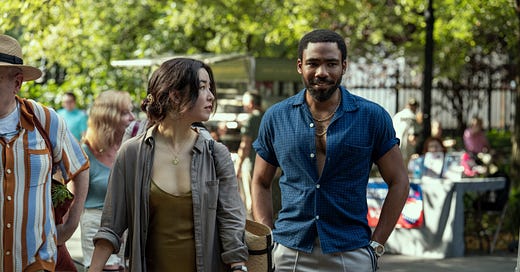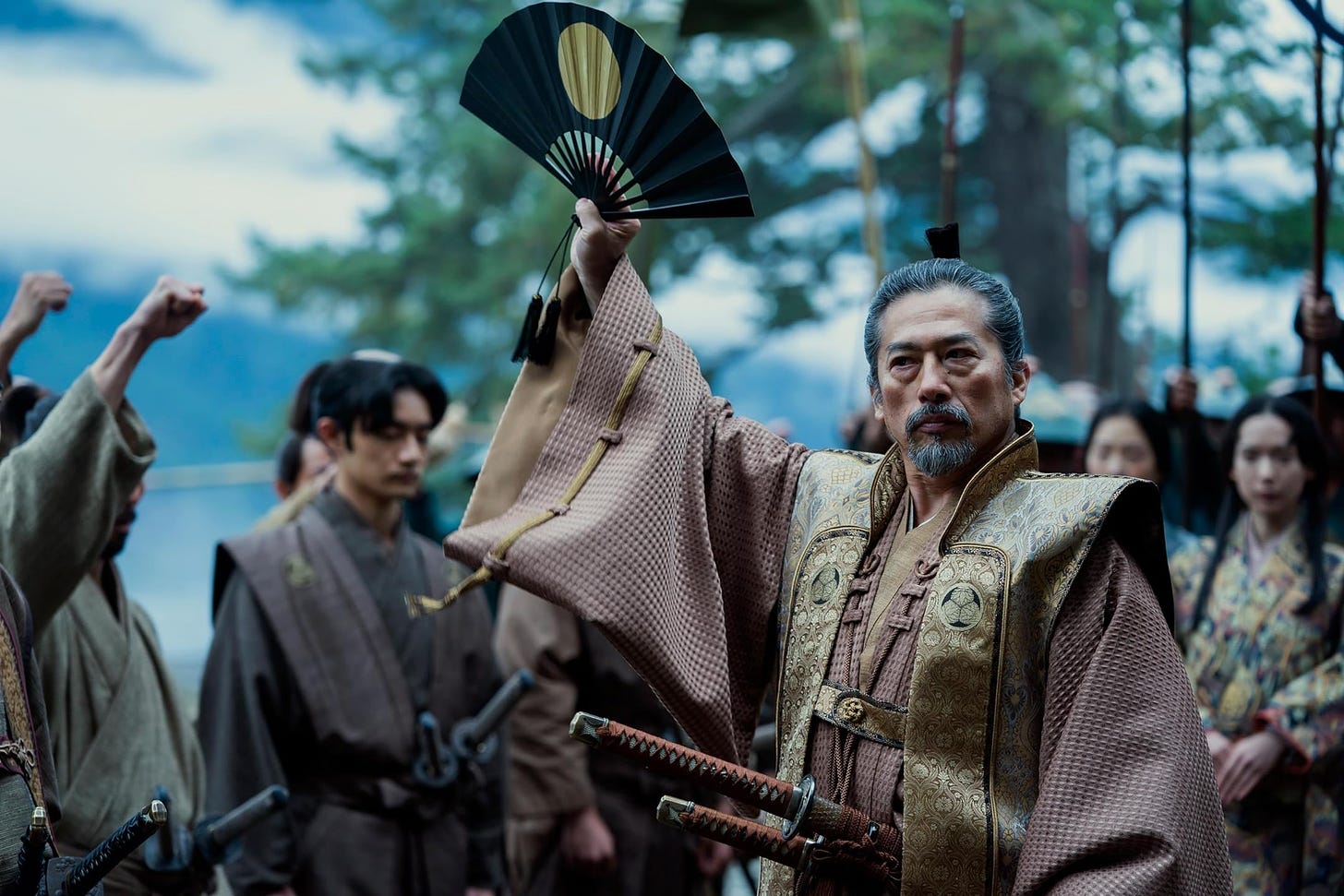The Primacy of Place
On on-location shooting in ‘Mr. & Mrs. Smith,’ ‘Tokyo Vice,’ and ‘Shōgun.’
MR. & MRS. SMITH IS AN AMUSINGLY CLEVER show in the sense that it takes an idea already used—from the film of the same name about husband and wife spies living together—and vastly improves upon it. Rather than being agents unbeknownst to each other, the show follows John (Donald Glover) and Jane Smith (Maya Erskine) as they get to know one another following placement into a marriage by a mysterious agency that has tasked them with performing high-risk espionage gigs. Steal a package and deliver it to this address, kidnap this real-estate billionaire and give him truth serum so he spills the beans about Epstein island, spy on a tech mogul to learn her secrets, that sort of thing.
Each episode mirrors a stage in a relationship’s development, from the meet-cute at their massive Manhattan brownstone to their first date at a charity auction gone awry to dealing with kids in the form of a mobster on the lam to couple’s therapy to breakup to reconciliation. Glover deploys the disarmingly standoffish air he cultivated over four seasons making Atlanta, while Erskine is a perfectly hardheaded foil. The concept is occasionally a little silly, but the action is shot well and the stars feel like old friends you enjoy seeing.
The real joy of the show, though, is that it all seems to have been shot on location. Or, at least, a great deal of it has been. I imagine the interiors were shot on a soundstage somewhere. But John and Jane are frequently seen walking and running and shooting and driving through New York City. When the Smiths take a trip to a ski chalet, the production actually went to a mountain that’s covered in snow somewhere in northern Italy. For the “honeymoon” episode in which they babysit a recalcitrant mobster, the production actually went to Lake Como, with the stars running up and down Italian streets, driving through winding curves, boating across placid lake waters, etc.
This sort of production can’t be cheap—on top of the on-location shooting, God only knows what Amazon spent on the guest stars alone, given the talent here includes Alexander Skarsgård, Parker Posey, John Turturro, Paul Dano, and Ron Perlman, among others—but the expense was worth it. It’s a TV show that feels like a James Bond movie: absurd action and plot grounded by real locations, nice clothes, cool cars, and suave leads. Most importantly: It’s not a Disney+ program shot in The Volume. It’s not green-screened to within an inch of its life. It feels real because it exists in real places with real people. There’s something to be said for that.
TOKYO VICE IS ANOTHER production that benefits greatly from being shot mostly on location. Ansel Elgort’s performance as a stranger in a strange land—Jake Adelstein, an American who becomes the first Westerner to work for a prestigious Tokyo daily—only really works if we truly believe him to be a stranger and that the land is truly strange. While some of that can be accomplished via interior set design, such as the hostess club where Samantha (Rachel Keller) guides a gaggle of women through the process of seducing the men who come for bottle service and nice conversation (but no sex) or the office-clubhouses of Yakuza gangsters like the one occupied by Chihara-kai thugs such as Sato (Shô Kasamatsu), you can’t feel the oppressive differentness without wandering the streets of Tokyo.
It’s just a whole different vibe, and one that would be difficult to accomplish if the HBO Max show were shot only on soundstages or a studio backlot, recycling the same alleyways over and over. You need the signage and the stoops, the decorations on tiny front porches, the way everything feels crammed together but carefully so. One can understand, intellectually, the danger that Adelstein faces as he and detective Hiroto Katagiri (Ken Watanabe) try to get a handle on Yakuza activity in the city; as a one-time reporter, I can identify, emotionally, with the difficulty of being a cub reporter in a big city, unsure of the customs of your sources and your editors alike. But without being ensconced in that difference, transported to a different world, it would all hit differently.
Again, it’s just nice to be in a real place with real people. While I’m enjoying FX’s remake of Shōgun—another Japan-set show, though this one in the 1600s rather than during the leadup to Y2K—there’s something just a little bit off about the location. Any individual room or house is well done: immaculately constructed; perfectly dressed. One can even forgive the fact that it’s shot in the forests of Vancouver when dealing with the smaller villages. But when the directors pull out for wide shots of Osaka, the city is so clearly computer generated, the bays so clearly fake, the skies and the lighting so clearly wrong that it’s just a little bit grating.
The story is well done and the political intrigue is compelling: the British sailor John Blackthorne (Cosmo Jarvis) serves as a capable stand-in for Western audiences attempting to discern how, precisely, the various clans of Japan vie for power. There are strong Game of Thrones vibes for those of us a bit too young to remember the original 1980 limited series: Lord Yoshii Toranaga (Hiroyuki Sanada) feels a bit like Ned Stark (Sean Bean) in that he seems mostly honorable in a world filled with cutthroats; one gets Lannister vibes from Ishido (Takehiro Hira) as he tries to gain control of the ruling council. Throw in some Catholic and Protestant intrigue peppered with samurai fights, and you’ve got a stew going. Still. It all feels just a little fake.
And look, practically recreating Tokyo in 1999 is far simpler than practically recreating Osaka in the seventeenth century. I get it. If you’re going to do those wide shots, you pretty much have to deploy CGI. But I don’t have to love it.







